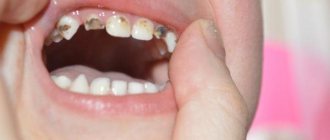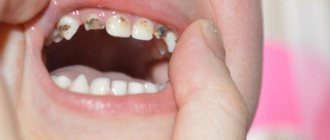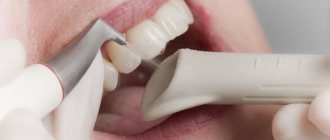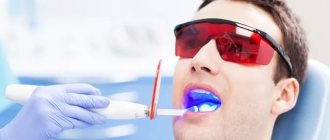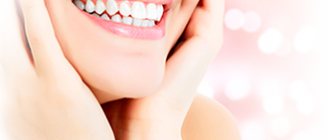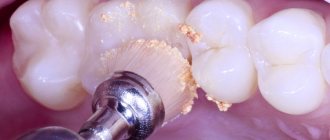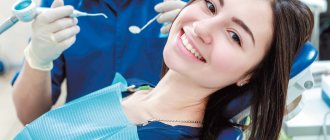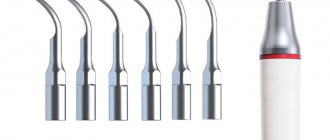Features of dental plaque in humans
Dental plaque is a kind of film invisible to the naked eye, consisting of living and dead microorganisms and bacteria.
Tartar is already a fairly hardened plaque that has a stronger and denser texture. It cannot be removed with a regular brush and paste.
Both plaque and stone settle on the surface of the teeth, gums, and in the space between the crowns, causing many pathologies. The accumulation of living and dead microorganisms can cause the development of caries, as well as gum diseases (periodontal disease, periodontitis). In addition, deposits spoil aesthetics - teeth become several shades darker and lose their shine. Professional dental cleaning of teeth and gums is necessary, even if the patient brushes his teeth several times daily. Here is the “gold standard” of affordable hygiene and mandatory dental care for teeth and gums.
Actions after the procedure
After ultrasound therapy, a patient with an incorrect bite must be given a pause, during which he does not put on braces.
If after the session it is planned to continue dental treatment, the patient is given several days of rest to restore areas with thinned enamel.
Then the doctor begins filling or installing dentures.
After ultrasound therapy, a patient with a malocclusion must be given a pause, during which he does not put on braces. This is also required to restore the enamel.
Also after therapy, slight bleeding of the gums is possible. In this case, the dentist takes action to stop it.
Why does plaque settle on the teeth and then tartar form?
- due to the fast and not entirely thorough daily brushing of teeth - normal brushing should last at least 3 minutes;
- due to incorrect selection of toothbrush or toothpaste - for example, too soft bristles;
- when the patient does not clean the gums enough and does not clean the tongue (a large amount of bacteria also accumulates on the tongue);
- if the patient eats “simple carbohydrates”, carbonated drinks, foods with a high content of dyes;
- when the patient smokes and drinks alcohol;
- with an unbalanced diet;
- with increased salivation;
- if the patient suffers from diseases in which a large volume of pathogenic bacteria accumulates in the oral cavity;
- when eating viscous foods, etc.
Note!
The formation of tartar is a natural process that cannot be avoided, even by observing strict rules of personal oral hygiene. It is very important to monitor this by cleaning at least twice a year (or more often, as directed by your doctor).
Kinds
Plaque is divided into two categories. First, supragingival stone appears, the cause of which is poor oral hygiene. Such deposits are located above the upper edge of the gingival crest, so they are easily diagnosed during a routine examination.
The characteristic features of supragingival tartar include:
- Localization on the inner surface of the tooth, from the side of the tongue;
- White or yellowish tint;
- The consistency is hard or clay-like.
The plaque is unstable, so it can be removed mechanically without any problems.
Subgingival calculus appears as a result of the fact that supragingival plaque descends down the root of the tooth and mineralizes. It forms in the gum pocket and is diagnosed only when using special dental instruments. Such deposits are considered age-related and most often appear in people over 40 years of age. If personal hygiene rules are not followed, it can appear at any age.
Signs of tartar:
- Dense and hard consistency;
- Light brown or greenish-black tint;
- Swelling and bleeding gums.
Features of professional cleaning from plaque and tartar
The work is performed by a dental hygienist, who, using special tools and solutions, removes all deposits from the surface, in the space between the crowns, and also from under the gums.
It is important!
If the patient has overly sensitive enamel, professional cleaning should be carried out no more often than once every twelve months.
After a complex of cleaning, the enamel becomes several shades lighter (do not confuse the procedure with whitening, these are still different things), the surface becomes smoother, shine appears, the general condition of the gums noticeably improves, and most importantly, the patient has a feeling of cleanliness of the oral cavity after a complex hygiene.
The professionalism of a dentist is not only to clean teeth and gums from hard stone, but also not to touch the deep layers of enamel, not to cause chips, cracks and loss of filling material.
Advantages and disadvantages of ultrasound therapy
Thorough treatment of all root canals is the main advantage of ultrasonic teeth cleaning
The most important advantage of the service is the tangible cosmetic effect.
After the session, the patient is completely free of plaque in any part of the tooth surface. His teeth become brighter due to the whitening effect.
Unlike alternative methods of mechanical and chemical action, ultrasonic vibrations are not harmful to enamel and gums, and the procedure itself is quick and does not hurt.
Modern hardware ultrasound technologies have the following advantages:
- thorough treatment of all root canals;
- smoothing the relief surface of the enamel;
- correction of teeth shade in smokers;
- teeth whitening effect.
Unfortunately, the technique is not without a number of disadvantages:
- the presence of a large number of contraindications;
- the likelihood of mechanical injuries to dentin;
- high cost of treatment;
- Ultrasonic cleaning does not provide permanent results, so re-treatment may be required after one or two years.
The extent to which the benefits of ultrasound therapy outweigh its negative aspects depends on the professionalism of the dentist. Therefore, when making an appointment, pay attention to the reviews and qualifications of the doctor who will clean your teeth with ultrasound.
When should teeth be cleaned to remove hard tartar?
- when your gums bleed;
- when the enamel acquires a rough texture;
- if the patient feels the presence of sharp edges of deposits (especially on the lower units);
- if the enamel becomes dull and acquires a grayish or yellowish color;
- with a “smoker’s plaque”, and this is accompanied by an unpleasant odor from the patient’s mouth;
- as mandatory hygiene before orthodontic treatment;
- after wearing braces;
- at the preparatory stage before the installation of veneers, before future artistic restoration;
- as a mandatory prevention of diseases of teeth and gums - at least once every six months.
When is it not recommended to brush your teeth?
This method of hygiene should be abandoned during pregnancy and breastfeeding, as well as in case of kidney disease and tuberculosis. The procedure should be carried out extremely carefully (or not at all) in cases of depleted and very thin tooth enamel, extensive caries lesions, viral diseases, immune pathologies, as well as in cases of diseases in the acute stage (for example, bronchitis, tonsillitis, etc.). Allergy to medications is also considered a contraindication for cleaning (for example, when performing Air Flow cleaning).
Contraindications
A significant drawback of the procedure is the presence of contraindications. The doctor will definitely ask if you have any diseases or orthopedic structures, the presence of which implies a refusal to carry out cleaning.
Contraindications in this case include:
- acute bronchitis, asthma;
- diseases of the heart and blood vessels, installed pacemaker;
- infectious diseases, including ARVI;
- first trimester of pregnancy;
- presence of implants, bridges, braces;
- in a separate line – epilepsy, hepatitis, HIV.
It is also not recommended to perform the procedure on children's baby teeth.
Types of professional teeth cleaning: Air Flow, ultrasonic, laser, etc.
- Ultrasonic teeth cleaning is one of the most popular methods of removing tartar and plaque from under the gums, as well as from the teeth themselves and in the space between the crowns. To carry out the procedure, a dental apparatus with a scaler is used, which delivers ultrasound waves, breaking hard plaque into microparticles. Remains of bacteria are washed off with water. The equipment copes with even the largest and oldest deposits, subgingival calculus, as well as the so-called “invisible” supragingival deposits.
Average duration – should be carried out up to 45 minutes.The need for anesthesia is not always necessary. In some cases, an anesthetic gel is applied to the patient's gums.
The level of discomfort during the procedure is minimal.
- Laser teeth cleaning – the procedure is carried out using a laser device. A fluoride-containing gel is applied to the teeth and a laser beam is applied, which lasts for about 15 minutes. Particles of removed plaque and stone are removed with a stream of water. The laser beam eliminates hard deposits, as well as soft plaque, the so-called “cigarette plaque”, and “complex” subgingival calculus. A gentle and painless method that allows you to achieve perfect sterility. The laser also helps strengthen gums. After the procedure, the doctor may suggest polishing the teeth, due to which the effect is achieved as if after whitening.
Average duration – should be carried out up to 30 minutes.Anesthesia is not necessary.
There is no discomfort during the procedure, it is performed silently, the patient can feel a pleasant warmth.
- Air Flow is a professional procedure that involves treating teeth and gums with abrasives and air. The actions are combined with polishing and improving the tone of the enamel (the shade changes by a couple or three tones). The Air Flow procedure can be either separate or combined with ultrasonic teeth cleaning. The Air Flow procedure is based on the operation of a special machine that supplies a strong stream of water with abrasive microparticles. As a result, it is possible to wash away plaque from the teeth themselves, as well as from under the gums, in the difficult space between the crowns. The water jet works gently and prevents overheating of tooth enamel. At the same time, a high-quality gum massage is performed, which has a beneficial effect on blood circulation and the health of the gum tissue.
The average duration of dental treatment is about 40 minutes.There is no need for anesthesia when performing Air Flow, since the procedure does not cause pain.
Discomfort – with Air Flow there is no discomfort; a noticeable result is visible immediately after cleaning by the dentist. The powder contains aromatic particles that freshen breath.
- Chemical teeth cleaning is a highly effective procedure for removing plaque and tartar using chemical reagents that dissolve formations. The method is used when, for example, ultrasonic cleaning and Air Flow cannot cope with deposits. A chemical mixture with the addition of hydrogen peroxide is applied to the old stone and washed off after a few seconds.
Average duration – should be carried out for 25 minutes.The need for anesthesia is not always necessary; in general, with a professional approach, the procedure is painless.
- Manual cleaning of plaque is a procedure without the use of devices. The method is implemented using a special tool: hooks with sharp tips, with which the dentist “catches” the subgingival stone and removes it from hard-to-reach places.
Average duration – should be carried out up to 30 minutes.Anesthesia is necessary; the gums are covered with an anesthetic gel.
There is no discomfort with the right approach; a professional dentist performs everything carefully, without injuring the teeth and gums.
Operating principle of ultrasonic cleaning
Tartar removal using ultrasound is based on the destructive effect of high-frequency waves on hard deposits. The procedure is carried out using a special attachment - a scaler.
The directed action of the waves explains the fact that the stone practically crumbles before our eyes, turning into powder. The simultaneous supply of water washes away plaque and cools the tooth, relieving discomfort.
The main advantage of the method is that using a scaler you can clean subgingival pockets. Laser and chemical cleaning do not provide this opportunity.
Another important point is the bactericidal effect. Under the influence of ultrasonic waves, pathogenic bacteria that cause dental damage and oral diseases die.
Recommendations after teeth cleaning to maintain and prolong the effect of the procedure
- Do not brush your teeth for the first 24 hours, but you can use dental floss and rinse your mouth for a minute with plain water;
- remove foods and drinks with coloring pigments from your diet;
- in the future, use a medium-hard toothbrush (it is advisable to choose it in tandem with your dentist);
- change your toothbrush about once a quarter;
- choose a paste taking into account the condition of your enamel and the characteristics of your teeth and gums (it is also better to do this in tandem with a doctor);
- Follow the rules of good daily oral hygiene.
Is it possible to brush teeth with ultrasound during pregnancy?
The best period for preventive cleaning is the second trimester of pregnancy. At this time, the child is already reliably protected by the placenta and is actively developing. Increased growth of the skeletal system provokes tooth decay in the mother, so we must try to protect ourselves as much as possible.
Ultrasonic cleaning with the addition of Air-Flow is considered by experts to be one of the best methods of prevention, as it allows you to sanitize the oral cavity as effectively as possible. The risk of caries is reduced, which allows you to simply save your teeth.
Before visiting a dentist, you must obtain permission from a gynecologist, since the decision is made individually, based on the woman’s condition.
Important. Ultrasound does not affect mother and child and does not cause allergies. The procedure is painless, and the mother feels excellent after the session.
How much does a good scale cleaning cost?
Today, effective removal of tartar in Moscow costs around 3,500 rubles. This amount includes:
- patient consultation with a dental hygienist;
- anesthesia (if necessary);
- use of a mouth dilator;
- removal of hardened deposits - in the sub- and supragingival zones;
- grinding of all teeth;
- recommendations for home oral hygiene and prevention.
If you go by the price list of the 32 Dent clinic, the cost of hygiene using the gentle and comfortable Air Flow method will be approximately 4900 rubles. This amount includes:
- elimination of pigmented plaque using the Air Flow device;
- grinding and polishing with dental paste;
- selection of individual products for oral hygiene and prevention tips.
All the measures that we have described relate to the powerful prevention of caries and other pathologies of the oral cavity. It is much easier, more comfortable and more profitable to perform such inexpensive and relatively simple prevention than to spend a lot of time, effort and finances on treatment in the future.
Sources:
- Personal experience as a periodontist;
- Borovsky E.V., Ivanov V.S., Maksimovsky Yu.M., Maksimovskaya L.N. Therapeutic dentistry. Textbook / - M.: Medicine, 2001;
- Grudyanov A.I., Ovchinikova V.V. Prevention of inflammatory periodontal diseases. - M., 2007;
- Danilevsky N.F., Magid E.A., Mukhin N.A., Milikevich V.Yu. Periodontal diseases. - M.: Medicine, 1993;
- Kuryakina N.V., Savelyeva N.A. Dental prevention. — M.: Med. Book N. Novgorod: Publishing house NGMA, 2003;
- Ulitovsky S.B. Oral hygiene in periodontology. - M.: Medical Book, 2006;
- Ulitovsky S.B. Encyclopedia of preventive dentistry. - St. Petersburg, 2004;
- Ed. Maksimovsky Yu.M. - Therapeutic dentistry. - M.: Medicine, 2002.
Choosing a method
Deposits on teeth can only be removed in a dental clinic using modern techniques, such as ultrasound, powder jet, instrumental, etc.
Ultrasound method
Ultrasonic cleaning uses a so-called scaler, the tip of which creates oscillatory movements with a frequency of 25-30 thousand Hz. Thanks to this, all deposits, both hard and soft, are removed.
Air-Flow method
With the Airflow powder blasting technique, soft deposits disappear instantly. The essence of this technique is to supply a strong aerosol jet through a special thin tube. It consists of air, water and a cleaning powder that knocks down all deposits from the most remote corners and gum pockets, up to 10mm deep.
Dry cleaning
Chemical treatment of deposits is based on the use of a special composition that easily softens deposits and allows them to be removed from teeth without difficulty. The procedure has many disadvantages (for example, the likelihood of damaging enamel or soft tissue, an unpleasant taste in the mouth, the inability to cope with hard deposits), which is why it is used less and less in practice.
Mechanical cleaning
The instrumental method - curettage, is used in cases of stone deposits in the gum pockets and under the gums, when other methods are ineffective. In this case, not only deposits are removed, but also pathologically altered gum tissue.
Laser Application
Laser technology in the treatment of dental plaque has proven itself to be effective and safe. In this case, the deposit is removed layer by layer, a painless method. The disadvantage is the high price, but the treatment is suitable even if children need help.
